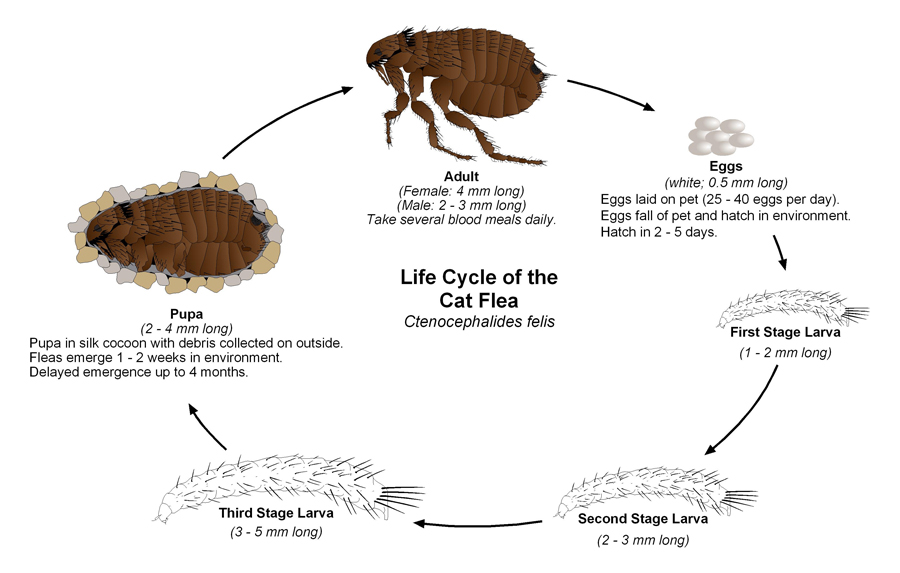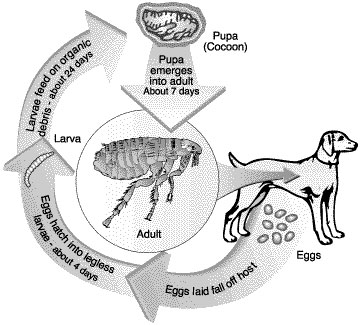flea life cycle human host
One half 50 of the average homes flea population are flea eggs. The female Pulex Irritans is 25 to 35 mm long while the males measure 2 to 25 mm but have complex genitalia.

Flea Control The Hearts Pest Management Way
After finding an animal or human host and taking a blood meal adult fleas will mate and begin laying eggs in the fur and surroundings of the host.

. These eggs endure on the garbage of the host for example portions of dry skin dried faecal matter and dried blood. General Flea Life Cycle. The life cycle for a flea typically starts when an adult female will lay their eggs after feeding on blood from a suitable the host this is mainly cats or dogs.
After mating tiny pearl-like eggs are laid on the surface of the host. The male and female fleas lean toward a warm and damp condition for mating. 2 Eggs are laid in batches of up to 20 or so usually on the host itself which easily roll onto the ground.
Help your pet break the flea life cycle with a flea treatment. The next stage of the flea life cycle is larvae at this point they have no legs and can be around 12 an inch long and are white in color. Adult cat and dog fleas can live up to one year in ideal situations but only about one to.
The life cycle of a flea generally takes 21-28. Females can lay up to 40 eggs per day and the eggs can take anywhere from 2 days to 2 weeks to develop and hatch. After that the fleas enter the pupal stage and create a cocoon the fleas can remain in.
To understand this better its important to know the flea life cycle. Photograph by University of Florida. The adult flea will find a host immediate after coming out from the cocoon.
Life Cycle Back to Top The cat flea life cycle is one of complete metamorphosis involving the stages of an egg larva pupa and adult. The life cycle of human fleas consists of eggs larvae and pupa and these are commonly seen inside homes along with the adult fleas. Fleas like other holometabolous insects have a four-part life cycle consisting of.
The 3rd stage of the flea life cycle is the Pupa stage. The chigo flea Tunga penetrans is discussed separately here. The Flea Life Cycle.
The life cycle can be broken down into three stages. This is because fleas in different stages of the flea life cycle have different needs. After the pupa hatches the adult flea is ready to feed and reproduce.
To answer the question quickly adult fleas can live without a host for only a few days up to two weeks max. In the wake of mating small pearl-like eggs are laid on the outside of the host. She can lay up to 50 eggs at a time over a 3 months period.
Understanding the Flea Life Cycle 7 Facts 1. This stage of the life cycle lasts up to two weeks. Fleas may bite humans but will wait for a preferred host such as a dog cat raccoon etc to permanently infest.
The number of days may vary depending on the availability of required conditions. The life span of the flea starts from the life cycle of the egg larvae pupa and adult. Pupae of the cat flea Ctenocephalides felis Bouché.
Fleas are parasites that need blood. Fleas like other holometabolous insects have a four-part life cycle consisting of eggs larvae pupae and adults. But the keyword there is adult.
Fleas at other life stages may survive longer without a host up to nine months. This cycle usually lasts 30 to 75 days yet may vary due to external factors such as temperature and humidity. The first stage the flea will hatch the egg between 2 to 12 days.
Flea the common name for the order Siphonaptera includes 2500 species of small flightless insects that survive as external parasites of mammals and birdsFleas live by consuming blood or hematophagy from their hostsAdult fleas grow to about 3 millimetres 1 8 inch long are usually brown and have bodies that are flattened sideways or narrow enabling them to move. This can infect cats dogs and rabbits as well as biting humans too causing itchiness but also transmitting diseaseThere are different life stages that the flea goes through which we refer to overall as the flea life cycle. Stage 1 The Egg.
The answer to that question is not quite as simple as youd expect. Eggs are the beginning of the flea life cycle and are laid after a blood meal from a host. This diagram shows the typical lifecycle of fleas.
The pupa stage lasts about 1-2 weeks before hatching into an adult flea. Life Cycle of Flea. Most of the fleas about 95 live as eggs larvae or pupa.
Fleas are one of the most common parasites that vets see in practice in particular Ctenocephalides felis the cat flea. Life Cycle of Flea. During this stage the larvae wraps itself into a cocoon to continue its growth into an adult flea.
Image will be uploaded soon 1. The larvae will only move off the host to feed on flea dirt. A female flea lays around 50 eggs.
As such the duration of time a flea takes to transition from one. The life cycle of fleas is not easy to understand but there is a general rule of thumb that you can use to estimate how long it takes for fleas to die on humans. These eggs persist on the debris of the host such as parts of dry skin dried excrement and dried blood.
Humans are not ideal hosts for fleas. After finding an animal or human host and taking a blood meal adult fleas will mate and begin laying eggs in the fur and surroundings of the host. The Flea Egg.
Despite common belief fleas prefer to remain on one host and do NOT like to jump from host to host. They can be found in soil carpet floorboards and even bedding after falling off the host animal when it moves. The rule states that a flea to die after being removed from its host takes about half a day.
The process can take anywhere from two to three weeks to several months depending on the conditions. If the flea cant find any food in a few days it will die. The female flea can start laying eggs after her first meal.
Humans with close contact with birds may also be fed upon by the sticktight flea Echidnophaga gallinacea. Egg larva and adult. Human fleas are more or less similar to dog and cat fleas in physical appearance.
The lifecycle of fleas can be very quick or last many months to years depending on the environmental conditions throughout the life stages. The flea life cycle goes from egg to larva to pupa before the final adult stage. Clean the house.
Without blood adult fleas cannot reproduce. When the pupa gets a sign that a host is near they will come out of their cocoon to feed. The male and female fleas prefer a warm and humid environment for mating.
Eggs will hatch in one to ten days depending on environmental conditions such as temperature and humidity. The flea life cycle begins when the female lays after feeding.
The Flea Life Cycle And How It Guides Flea Control And Prevention

Schematic Life Cycle Of Ctenocephalides Felis Download Scientific Diagram

A Veterinary Nurse Led Approach To Flea Control The Veterinary Nurse
Ectoparasites Fleas Ticks Mites The Woof Wagon

Flea Life Cycle Comfortis Spinosad

Flea Infestations Epidemiology Treatment And Control The Veterinary Nurse

Diagram Of Plague Transmission 1 Flea Life Cycle Fleas Lay Their Download Scientific Diagram

Flea Definition Size Natural History Britannica

How Long Can Fleas Live Without A Host 20 Big Questions Answered Pest Strategies

How Long Can Fleas Live Without A Host 7 Things To Know

Flea Biology And Human Health Significance

The Flea Life Cycle Why Fleas Are Difficult To Control Maggie S Farm Ltd
Flea Control In Sydney Pest Control Company Sydney

Flea Definition Size Natural History Britannica

Fleas Public Health And Medical Entomology Purdue Biology Entomology Insects Ticks Diseases Monitoring Control Hot Topics Agriculture Extension



